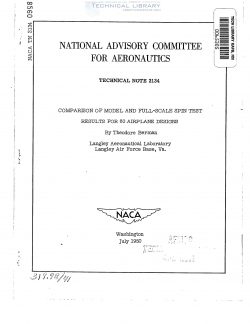naca-tn-2134
- Version
- 107 Downloads
- 705.55 KB File Size
- 1 File Count
- December 9, 2016 Create Date
- December 9, 2016 Last Updated
National Advisory Committee for Aeronautics, Technical Notes - Comparison of Model and Full Scale Spin Test Results for 60 Airplane Designs

The results of Langley spin-tunnel investigations have been compared
with corresponding full-scale results available for 60 different airplane
designs. The purpose of the comparison was to determine the reliability
of the model results in predicting full-scale spin and recovery
characteristics.
Analysis of the data showed that model tests satisfactorily predicted
full-scale recovery characteristics approximately 90 percent of the time.
For the remaining 10 percent of the time, the model results were of value
in predicting some of the details of the full-scale spins. Generally,
when the models spun at angles of attack less than #50, the corresponding
airplanes spun at larger angles of attack; and when the models spun at
angles of attack greater than #50, the corresponding airplanes spun at
smaller angles of attack. When the tail—damping ratio was greater than
0.02, the models spun with higher rates of rotation than the airplane;
and when it was less than 0.02, the models spun with lower rates of rota-
tion. Generally, the models spun with less altitude loss per revolution
than the corresponding airplanes, but a higher rate of descent was found
to be associated with the smaller angle of attack, whether of airplane or
model. The airplanes generally spun with the inner wing down more than
the inner wing of the corresponding models.
Predictions of emergency—recoverysparachute sizes based on model
results were found to be somewhat conservative.
The Langley 20—foot free-spinning tunnel is utilized to determine
the spin and recovery characteristics of airplanes by means of model tests.
It is therefore desirable that the accuracy of the model tests in pre-
dicting full—scale spin results be known. In pursuit of this objective,
a comparison of the available results of model and full-scale spin tests
for 21 designs was reported in reference 1. The information available for
that comparison was rather meager. Since that time more models have been
tested and more full-scale data have become available and it was thought
desirable that all these data be analyzed to determine the correlation
between model and full-scale spin tests.
| File | Action |
|---|---|
| naca-tn-2134 Comparison of Model and Full Scale Spin Test Results for 60 Airplane Designs.pdf | Download |

Comment On This Post